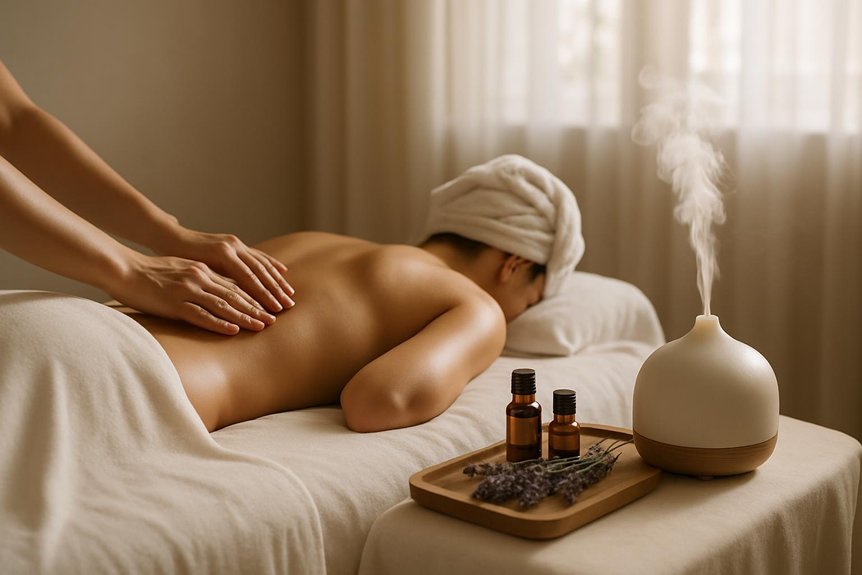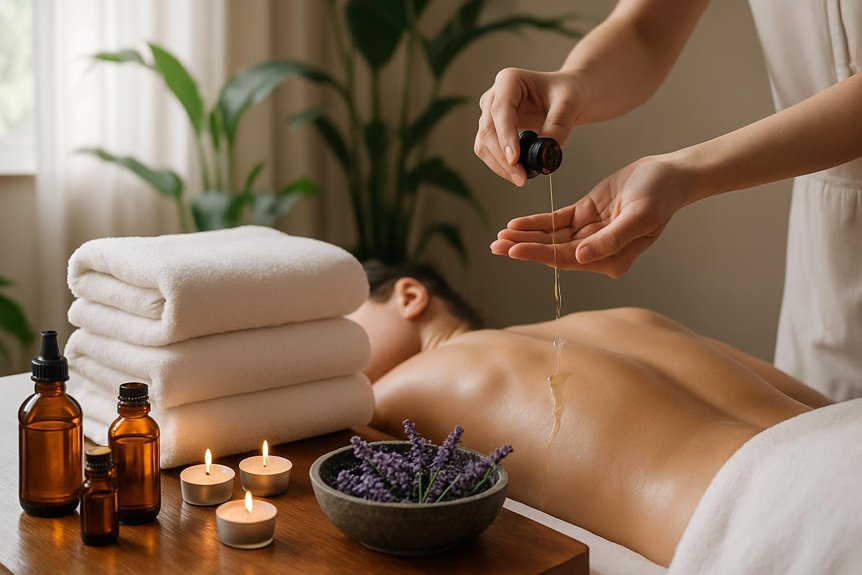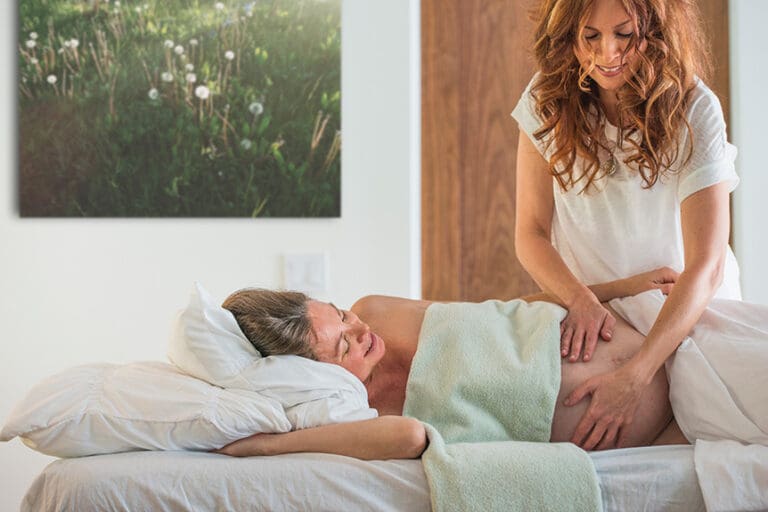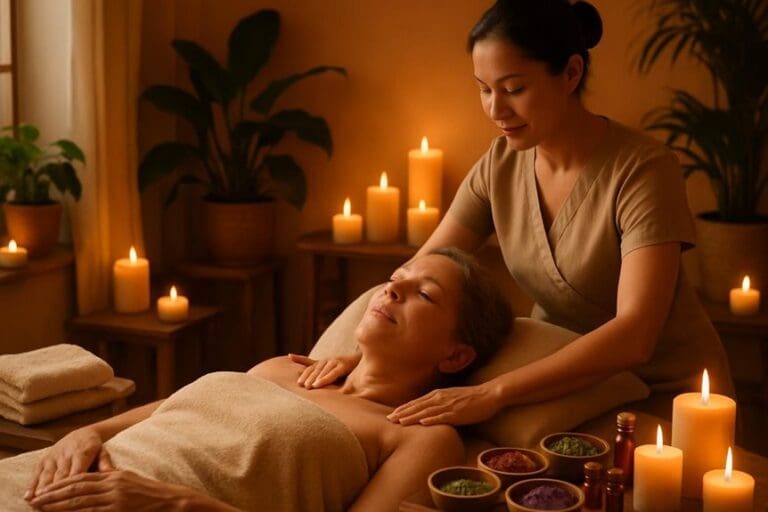Essential oil massage pricing is built on session length, therapist expertise, local demand, oil quality, and clinic overheads. A 60‑minute base rate anchors costs; 30 minutes typically 60–70% of that, 90 minutes ~1.5x, 120 minutes ~1.9–2.0x. Rates rise with senior therapists, premium therapeutic-grade oils, evening/weekend slots, and complex bespoke blends. Costing should include consultation, aftercare, 1–3% dilution (6–18 drops/30 ml), wastage, and linens. Clear menus, packages, and upgrades support client trust and value—here’s how to set them well.
Understanding What This Massage Includes

What exactly does an essential oil massage include? At Spa & Massage, it blends evidence-based touch with therapeutic essential oils to support relaxation, mood balance, and soft-tissue comfort. A session typically begins with a brief consultation to identify goals—calm, uplift, or muscle ease—followed by a therapist-guided aroma selection.
In our clinics, diluted essential oils are applied with long, flowing effleurage, gentle kneading, and light-to-moderate pressure, adapted to sensitivity and preference. Breathing cues, quiet pacing, and warm towels help the body receive the scent and touch.
Our therapists prioritise skin safety: patch considerations, dilution ratios, and avoidance during pregnancy for contraindicated oils. Aftercare includes hydration guidance, unrushed passage, and recommendations for gentle movement and rest.
The intention is intimacy through precision—soothing, attentive, and clinically informed. Many people choose this service to relax and heal with essential oil massage, which is supported by a blend of skilled touch and the benefits of essential oils for overall wellbeing.
Factors That Influence Pricing
Even before booking, several variables shape essential oil massage pricing in London: session length, therapist seniority, clinic location, and the complexity of the treatment plan. Evidence shows clients value experienced hands; senior therapists typically command higher rates due to advanced training and nuanced blending of essential oils.
Central, high-demand postcodes often carry premium facility costs. At Spa & Massage, pricing also reflects bespoke oil selection and any added focus work—such as tension mapping—agreed during consultation.
Product quality matters. Therapeutic-grade oils, hypoallergenic carriers, and sustainably sourced botanicals increase costs but enhance outcomes and skin comfort.
Timing influences price: peak evening and weekend slots may be higher. Finally, package options can moderate spend while supporting consistent care—an approach our clinics use to deliver both value and continuity.
Setting Rates by Session Length
Building on those variables, session length is the clearest, most practical lever for setting essential oil massage rates. Practitioners typically anchor a base 60-minute price, then scale proportionally: 30 minutes at roughly 60–70% of the hour, 90 minutes at 1.5x, and 120 minutes at 1.9–2.0x to reflect therapist stamina and client value.
This ladder rewards clients who seek unhurried care while protecting margins. At Spa & Massage, tiered lengths serve distinct intentions: 30 minutes for focused relief, 60 minutes for full-body balance, 90–120 minutes for immersive, slow-paced work that invites deeper nervous-system downshift.
Pricing also accounts for realistic appointment time (consultation, changing, aftercare), so paid minutes reflect true hands-on care. Clear, transparent tiers help clients choose the intimacy of time they need—and return confidently.
Costing Your Essential Oils and Supplies
Spa & Massage approaches pricing by quantifying inputs: precise essential oil usage per session, carrier oil volumes, and consumables such as linens, towels, and disposables.
Therapists standardise blends (typically 2–3% dilution) and track ml-per-minute application rates to produce reliable per-treatment costs, while allocating overheads like laundering, cleaning, and equipment wear.
This cost clarity supports fair fees for clients and guarantees consistent quality across all London clinics.
Calculating Oil Usage
How much oil does a single essential oil massage really use, and what does that mean for pricing?
For a 60‑minute full‑body session, Spa & Massage therapists typically apply 20–30 ml of carrier oil, adjusted for body size, skin condition, and glide preference.
Evidence-based dilution is 1–3% essential oils: about 6–18 drops per 30 ml, with lighter blends for sensitive clients and pregnancy.
Warmer rooms and slower techniques require slightly more oil; faster, targeted work uses less.
Therapists measure in millilitres before the session and record actual usage afterward, averaging over a week to set a reliable per‑treatment oil cost.
They also plan for a 5–10% margin to account for spillage and residue, ensuring consistent touch, aromatic presence, and transparent pricing.
Supplies and Overheads
Knowing the average oil volume per session is only half the equation; pricing also hinges on the true cost of materials and clinic overheads.
A robust model prices each blend by millilitre, factoring essential oil dilution (typically 2–3%), carrier oils, and wastage. Spa & Massage therapists track cost-per-pump and per-drop to prevent undercharging while preserving quality.
Overheads then refine the figure: linens and laundry, diffuser upkeep, disposables, cleaning, licensing, bookkeeping, card fees, software, rent, utilities, staff training, and insurance.
Allocating these as a per-session burden (e.g., total monthly overheads divided by expected bookings) yields a reliable baseline.
From there, an ethical margin covers expertise and time while staying accessible. At Spa & Massage, transparent costing supports tailored blends, consistent quality, and calm, unrushed care.
Pricing Models: Flat Rate vs. Tiered Options
A clear pricing structure helps clients compare value and plan their wellness routine with confidence, and two common models—flat rate and tiered—serve different needs. Flat rates feel simple: one inclusive price per duration, ideal for clients who crave ease and consistency.
Tiered options segment by time, oil complexity, and therapist expertise, allowing nuanced choices without surprises.
From Spa & Massage’s perspective, transparency matters. In our clinics, flat rates work well for standard aromatherapy with premium base oils, while tiers reflect added essential-oil blending, longer sessions, or senior-therapist time.
Evidence from client feedback shows both models foster trust when inclusions are explicit: consultation time, oil customisation, and aftercare advice. A client-centric approach lists what each tier contains, highlights outcomes—relief, reset, deep rest—and invites clients to choose what feels right today.
Regional Benchmarks and Local Market Positioning
Building on clear pricing structures, regional benchmarks shape what fair value looks like for essential oil massage across London’s varied neighbourhoods. Evidence suggests clients anchor expectations to local living costs, transport links, and wellness density. Positioning that respects these cues builds trust and repeat visits.
In Spa & Massage clinics across Crouch End, Bayswater, Chiswick, Earl’s Court, Belsize Park, and Richmond, pricing reflects neighbourhood profiles: median household income, footfall patterns, and time-of-day demand. A 60-minute aromatherapy session typically commands a modest premium in zones with higher rents and commuter convenience, while maintaining parity in perceived quality across sites.
Transparent menus, consistent session lengths, and clear oil selections—blends tailored by our therapists—signal reliability. Monitoring booking lead times, utilisation rates, and review sentiment guides fine-tuning, keeping fees aligned with local willingness to pay without eroding accessibility.
Adding Value With Upgrades and Packages
Thoughtful upgrades and flexible packages elevate essential oil massage from a single treatment to a tailored wellness plan with measurable value. Evidence suggests that small, targeted enhancements improve perceived outcomes and loyalty.
Common upgrades include extended session time for slower, deeper aroma infusions; bespoke essential oil blends matched to mood or cycle; hot stone back add-ons; and focused scalp or foot rituals. At Spa & Massage, therapists curate blends and techniques to address stress, sleep, or muscular tension, then price each enhancement transparently as a modest, add-on fee.
Packages reward commitment and consistency. Tiered bundles—such as 3, 5, or 10 aromatherapy sessions—can include complimentary upgrades, priority booking, and gentle seasonal blend swaps. This structure helps clients maintain results while giving clinics predictable revenue and clearer staffing forecasts.
Communicating Price Transparently to Clients
Clear, upfront pricing reduces uncertainty, builds trust, and supports informed choices. Clients value knowing what is included in an essential oil massage—session length, oil options, and any surcharges—before they book.
Transparent menus, visible online and in clinic, should list standard rates, off-peak options, and packages, with taxes and card fees clearly stated. Plain language avoids confusion; tiered examples help clients match budget to expectation.
At Spa & Massage, therapists explain how bespoke oil blends, consultation time, and aftercare are reflected in the fee. They confirm total cost at booking, outline optional add-ons, and note cancellation terms without pressure. Email and SMS confirmations mirror the quoted price.
This consistency reduces price-related drop-offs, improves satisfaction, and supports long-term loyalty across our London clinics.
Conclusion
In the end, pricing essential oil massage becomes a measured choreography: oil costs tallied, session lengths mapped, qualifications weighted, London’s rents pressing at the edges. Clients see clarity, not guesswork—transparent menus, ethical discounts, smart bundles, careful contraindication checks. Evidence guides choices; value is felt in the room and read on the page. As seasons shift and demand swells, one question hangs—held just long enough to reassure: will the fee reflect the care? The answer unfolds—precisely, and fairly.



